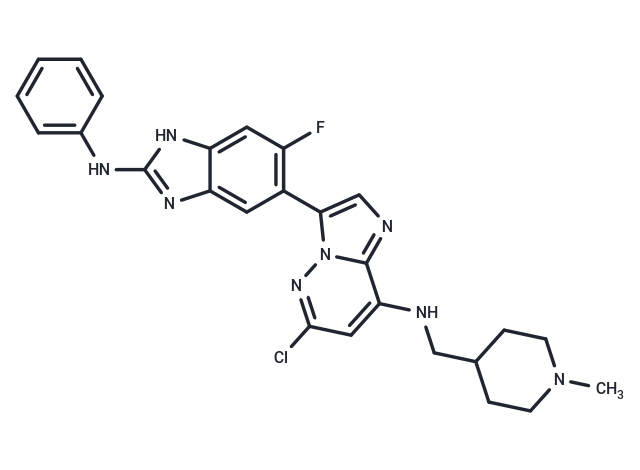Shopping Cart
Remove All Your shopping cart is currently empty
Your shopping cart is currently empty
IRE1α kinase-IN-1 is a highly selective IRE1α (ERN1) inhibitor, with an IC50 of 77 nM, displaying 100-fold selectivity over the IRE1β isoform. It inhibits ER stress-induced IRE1α oligomerization and autophosphorylation, as well as IRE1α RNase activity (IC50=80 nM).

| Pack Size | Price | USA Warehouse | Global Warehouse | Quantity |
|---|---|---|---|---|
| 1 mg | $118 | In Stock | In Stock | |
| 5 mg | $297 | In Stock | In Stock | |
| 10 mg | $475 | In Stock | In Stock | |
| 25 mg | $745 | In Stock | In Stock | |
| 50 mg | $1,070 | In Stock | In Stock | |
| 100 mg | $1,480 | In Stock | In Stock | |
| 1 mL x 10 mM (in DMSO) | $328 | In Stock | In Stock |
| Description | IRE1α kinase-IN-1 is a highly selective IRE1α (ERN1) inhibitor, with an IC50 of 77 nM, displaying 100-fold selectivity over the IRE1β isoform. It inhibits ER stress-induced IRE1α oligomerization and autophosphorylation, as well as IRE1α RNase activity (IC50=80 nM). |
| In vitro | IRE1α kinase-IN-1 (compound 31) effectively mitigates endoplasmic reticulum stress by hindering IRE1α oligomerization and phosphorylation, while also suppressing its endoribonuclease activity within human cells[1]. This compound demonstrates high specificity, showing greater than 70% inhibition for only 4 out of 455 kinases tested, indicating its select focus on IRE1α. It attenuates recombinant G547 IRE1α KEN domain pS274 autophosphorylation with an IC50 of 160 nM and disrupts ATP-site LanthaScreen tracer binding to the recombinant dephosphorylated G547 IRE1α KEN with an IC50 of 0.27 μM[1]. Additionally, it prevents tunicamycin-induced GFP-IRE1α foci formation in HEK293 cells with an IC50 of 0.74 μM and obstructs both tunicamycin- and thapsigargin-induced IRE1α-dependent XBP1 mRNA splicing, with IC50 values ranging from 0.68 to 1.63 μM in the same cell line[1]. In H929 and NCI-H929 cells, IRE1α kinase-IN-1 dose-dependently suppresses IRE1α-dependent XBP1s mRNA expression when applied at concentrations between 0 to 20 μM, demonstrating its potent inhibitory activity on tunicamycin-induced XBP1s expression[1]. |
| Molecular Weight | 504.99 |
| Formula | C26H26ClFN8 |
| Cas No. | 2328097-41-0 |
| Smiles | CN1CCC(CNc2cc(Cl)nn3c(cnc23)-c2cc3nc(Nc4ccccc4)[nH]c3cc2F)CC1 |
| Relative Density. | 1.48 g/cm3 (Predicted) |
| Color | White |
| Appearance | Solid |
| Storage | Powder: -20°C for 3 years | In solvent: -80°C for 1 year | Shipping with blue ice/Shipping at ambient temperature. | ||||||||||||||||||||
| Solubility Information | DMSO: 10 mg/mL (19.8 mM), Sonication is recommended. | ||||||||||||||||||||
| In Vivo Formulation | 10% DMSO+40% PEG300+5% Tween 80+45% Saline: 1 mg/mL (1.98 mM), Sonication is recommended. Please add the solvents sequentially, clarifying the solution as much as possible before adding the next one. Dissolve by heating and/or sonication if necessary. Working solution is recommended to be prepared and used immediately. The formulation provided above is for reference purposes only. In vivo formulations may vary and should be modified based on specific experimental conditions. | ||||||||||||||||||||
Solution Preparation Table | |||||||||||||||||||||
DMSO
| |||||||||||||||||||||
| Size | Quantity | Unit Price | Amount | Operation |
|---|

Copyright © 2015-2025 TargetMol Chemicals Inc. All Rights Reserved.